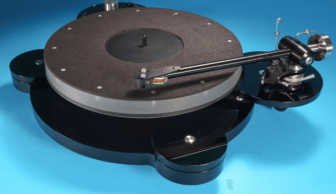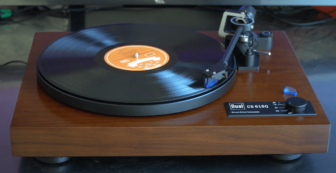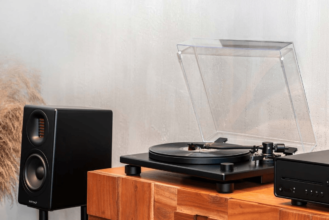Dohmann Helix Two Mk3 Review: Are they worth it?
From the man behind the iconic Continuum turntable comes this next-generation range, under his own brand, incorporating a ‘negative-stiffness mechanism’ suspension… Read our Dohmann Helix Two Mk3 Review.
The finely-engineered, and robustly elegant, turntable that graces the pages before you – the ‘Two’, one of a pair of decks in the Helix range, now in Mk3 guise – represents the latest thinking on the art and science of vinyl replay from Director Of Design Mark Dohmann.
All previous iterations of the Helix One and Two turntables may be updated to the current Mk3 standard, side-stepping obsolescence, while the brand’s UK footprint has just received a boost with its adoption into UK distributor Absolute Sounds’ ‘Ten’ artisan collection.
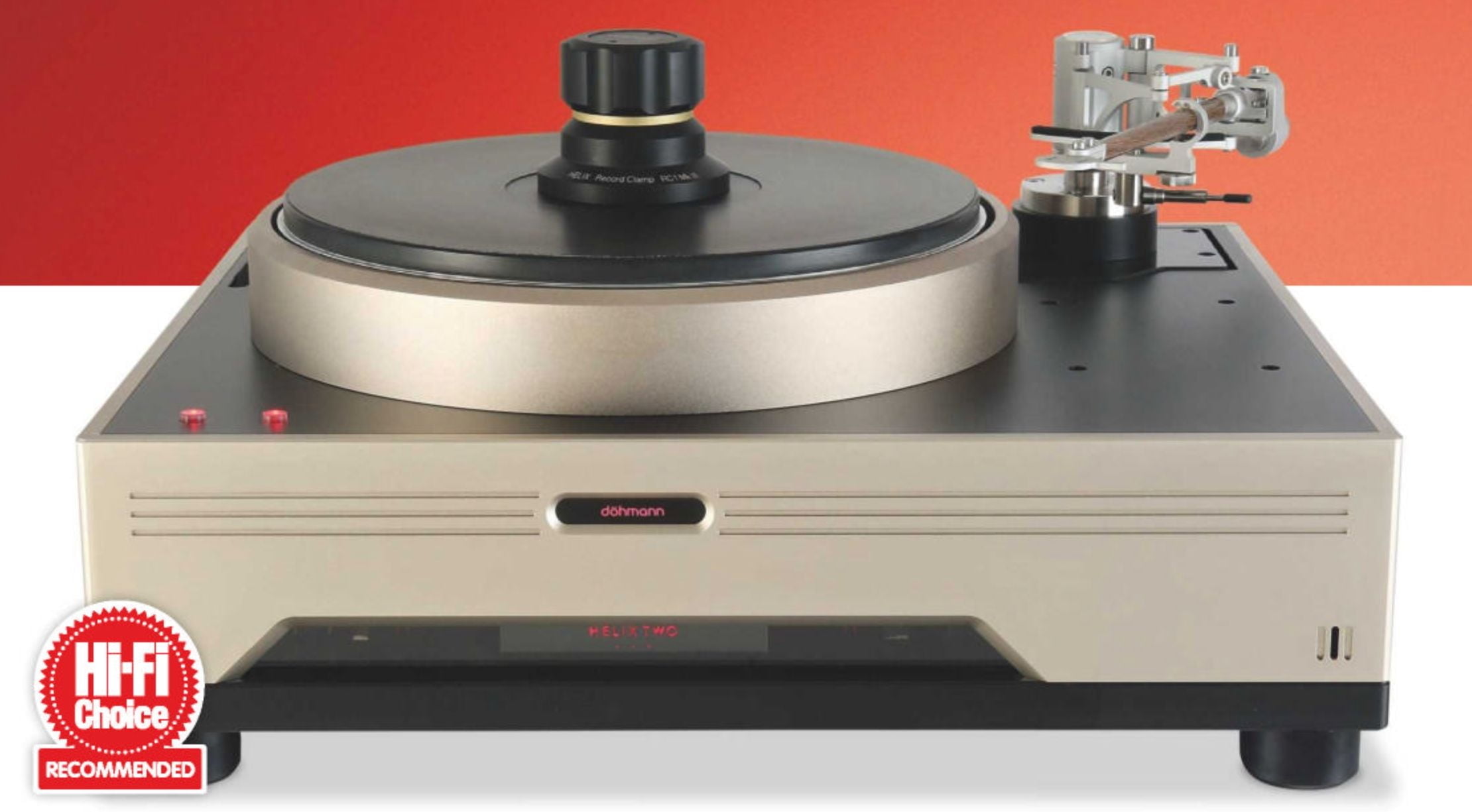
DETAILS
| PRODUCT | Dohmann Helix Two Mk3 |
| ORIGIN | Australia |
| TYPE | Belt-drive turntable with electronic speed control |
| WEIGHT | 38kg |
| DIMENSIONS (WxHxD) | 480 x200 x 400mm |
| FEATURES | 33 and 45rpm Facilitates the mounting of tonearms up to 12in; Dual-belt platter drive |
| DISTRIBUTOR | Absolute Sounds |
| WEBSITE | dohmannaudio.com absolutesounds.com |
The Helix Two is more compact than the flagship Helix One, which will accommodate two tonearms, but its more traditional proportions are arguably easier on the eye. The three colourways, matt black and silver at £ or titanium (which looks like ‘champagne gold’) at £, certainly tick all the boxes. There’s also a polished carbon-fibre top-plate option for those that like to go bling.
The chassis metalwork and subtle red illumination are very stylish while the substantial alloy ‘nest’ within which the platter rotates is reminiscent of Denon direct-drives of yore. The Helix Two Mk3 is belt-driven, of course, the two clear-polymer bands placed around the lower disc of the three-part platter during setup, before being pulled out and located around the motor pulley using a strategically placed length of string. It’s not exactly high-tech, but it is effective and anyone who used to own a Pink Triangle turntable in the Eighties and Nineties will understand the ritual.
Our sample also comes equipped with the Lithuanian Reed 5A tonearm, an exquisite piece of engineering that deserves a full review in its own right. Its ‘Double Birch/Thales’ geometry, promising near-tangential/bias-free tracking across the LP’s surface, is worthy of in-depth testing, and so we will likely return to this brand and model at some stage in the future.
Back to the Helix Two, where Dohmann, having previously been responsible for the design of the iconic Continuum Caliburn turntable, is now guiding this own-brand venture, already 10 years in the making, and waving a clean sheet at an age-old problem. Mark Dohmann puts the task very succinctly, noting: “Vinyl playback involves converting the vibrational energy experienced by a stylus as it moves through the grooves of a vinyl record into an electrical signal. The challenge is that there are other forms of vibrational energy (resonance) present in this environment that arise from various sources that are also picked up by the stylus”.
Dohmann’s response to all this unwanted resonance is multi-faceted, employing constrained-layer damping, tuned-mass dampers and critically pre-stressed material composites. This engineering is built into and around the polymer-constrained steel plates that form the suspended sub-chassis, including all the interconnected parts that are home to the inverted bearing, the Swiss-made, three-phase AC motor and laminated armboard.
The Helix Two’s suspension is separate and acts as the ‘foundation layer’ of its staunch defence against incoming vibration. It’s a variation of the BM-10 ‘Benchtop Vibration Isolation Platform’ designed by the pioneering brand Minus K from California and confers good isolation from sub-1Hz up to around 100Hz. Beyond this, Dohmann is relying on its tuned-damping and ‘pre-stress accumulation (and) release’ strategies to deal with extraneous noise -this is the basis of what it calls its ‘mechanical crossover’. The latter -the pre-stressed elements – are particularly focused on mitigating, or at very least channelling, chassis vibrations caused by motor and platter bearing noise. Frictional dissipation between the constrained layers accounts for about 20 percent and the (new) polymer damping material about 80 percent of the impact, with the use of these lossy materials extremely important in dealing with the highest frequencies.
Among the many upgrades incorporated in the Two Mk3, this distributed approach to vibration management is extended to every part of the deck, including the bearing, motor and armboard. The alloy armboard, for example, has now been replaced by one fashioned from a lightweight, rigid fibre/polymer laminate that offers improved self-damping in a specific frequency range identified by Dohmann.
The armboard is further decoupled from the sub-chassis via tethers, just as the motor has its own regime of vibration control. It’s all part of the brand’s ‘Resonance Suppression Architecture’ (RSA). Incidentally, Dohmann is also wedded to TLAs (three-letter acronyms), of which ‘RSA’ is just one of at least 10 declared on the Features section of the turntable’s useful website.
We really only mention this because the Mk3 version of the substantial, screw-down record clamp now also includes its own ‘RSA’. The original clamp was a traditional compression type, but the Mk3 includes a (Sorbothane-like) cross-linked polymer that’s injected into a chamber in the top section to address any spindle resonances. The lower section of the clamp, with its broad contact area, is designed to prevent needle chatter from travelling through the vinyl and ricocheting back out into the playback medium.
The Helix’s inverted bearing is a typically no-nonsense oil-lubricated hardened steel shaft running within steel bushes, the common coefficient of expansion allowing for very tight tolerances. The thrust pad is fashioned from tungsten carbide and runs on a silicon carbide ball – it’ll likely outlive us all. The outer sleeve of the bearing is integrated into the lower alloy portion of the platter, maintaining a low centre of gravity, while the top portion of the platter is machined from a hard polymer and includes the spindle. The spindle and bearing are otherwise unconnected…
The platter surface is covered with a fibrous mat, just 0.4mm thick and impregnated with an elastomer. The material is culled from the automotive racing scene where it’s used to cut down on ‘wheel squeal’. Again, this is
The Helix Two Mk3 perfectly reveals the nuances that come with high-end kit
another damping layer, albeit one that’s apparently very difficult to cut to shape without taking the edge off every tool it encounters!
The motor is in the same plane as the bearing, so there’s no yawing effect where the pulley might otherwise be fighting against the suspension. It’s a three-phase design synchronised at a very high 100kHz and runs at an approximate 10:1 ratio with the platter, so the drive spindle spins at ~333rpm when the platter is set for 33.3rpm. The partnering outboard PSU isolates the filtered DC output from the AC mains input within two separately screened enclosures.
INSIGHT
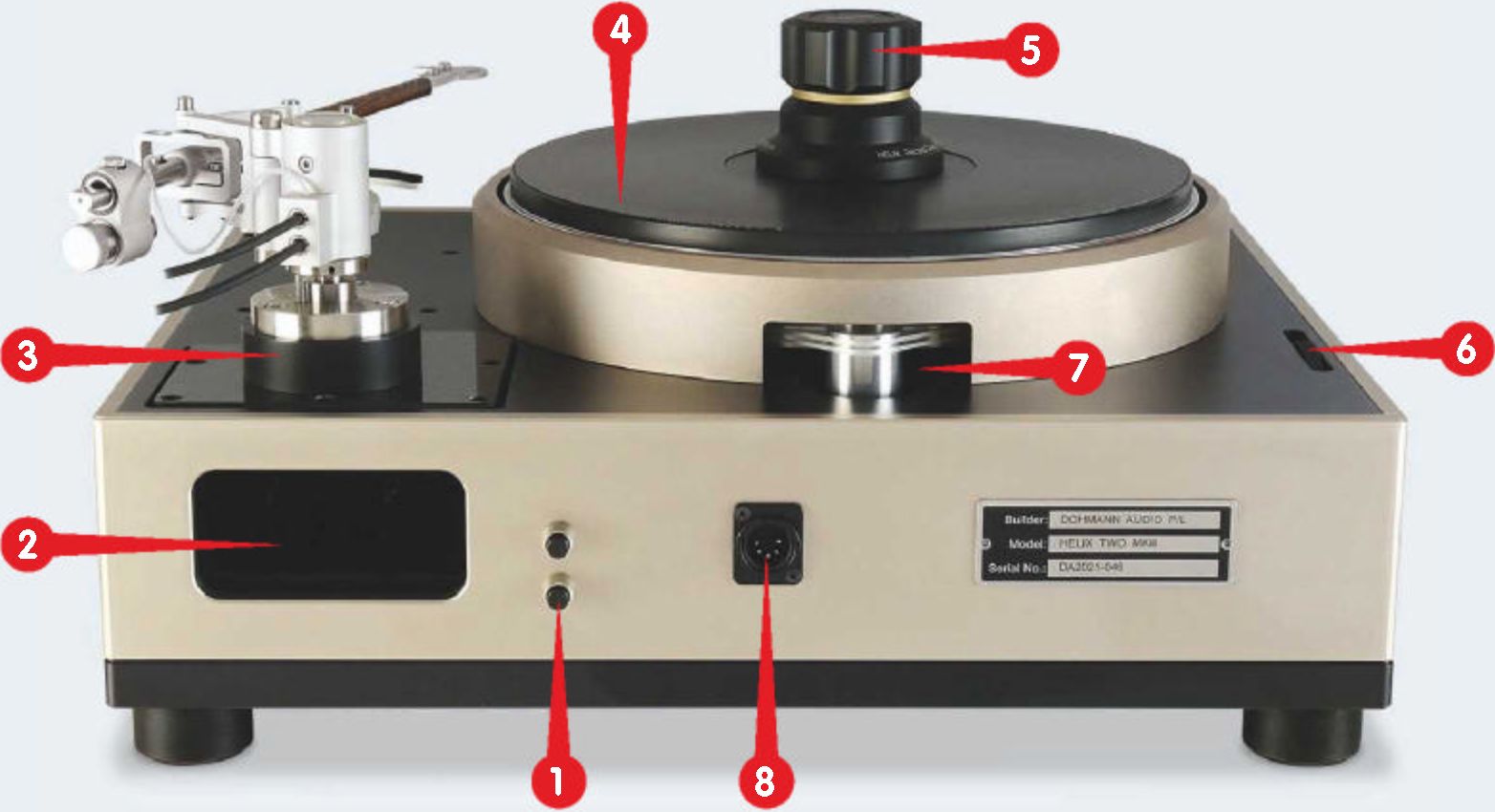
1 Fine speed control
2 Tonearm leads are ‘dressed’ and exit here
3 The armboard facilitates mounting tonearms up to 12in
4 Tri-Modal Platter system
5 Record clamp with RSA resonance control technology
6 Suspension balance adjustment
7 AC synchronous motor, pulley and dual-belt drive
8 Outboard PSU includes a combined 5-pin data and supply connection
HOW IT COMPARES
As the vinyl revival rolls on we are seeing more high-end turntables than ever before. Lacking the suspension of Dohmann’s Helix Two Mk3, the £k Air Force III Premium from TechDAS will still tempt you with its vacuum LP holddown, support for four separate tonearms, and rock-solid sound.
VPI’s Avenger Direct (£ with 12in Fatboy arm and cartridge) is a skeletal design that retains plenty of flesh on its musical bones -and there’s no belt to worry about! And, of course, no discussion about high-end decks could be complete without mention of SME’s flagship Model 60 with one-piece Series VA tonearm (£k+, depending on finish). Both deck and arm are at the apex of audio engineering -and combine to weave a compelling musical spell!
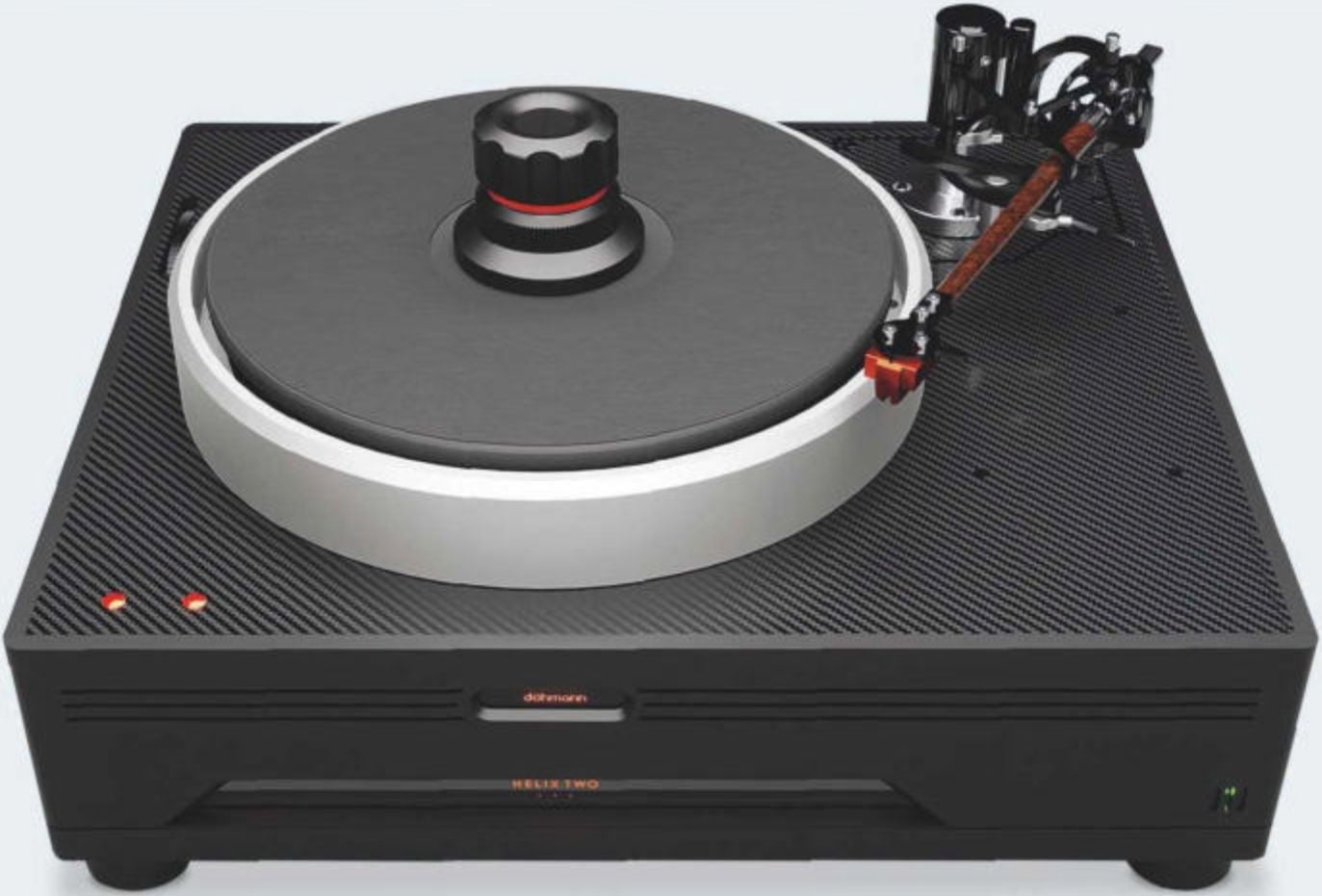
GOOD VIBRATIONS
Incorporated in 1993, California’s Minus K Technology operates at the sharp end of industrial and scientific vibration control. Laboratories carrying out critical laser experiments, high-resolution microscopy or other imaging, or NMR spectroscopy with huge, super-cooled magnets, all need to be very mindful of how the smallest of external vibrations will impact on the performance of these often very large instruments. Costly active isolators typically employ slaved sensors and actuators to mitigate incoming vibration – active noise cancellation – while passive ‘air suspension’ tables, using bladders and pumps, have also been a common go-to solution for heavyweight industrial isolation.
Minus K’s solution is passive and elegantly ‘tuneable’ but side steps the potentially noisy pump of a pneumatic platform for what it describes as a negative-stiffness mechanism (NSM). In its ultimate form this technology would comprise three isolators stacked in series: a tilt-motion isolator on top of a horizontal-motion
isolator on top of a vertical-motion isolator. For a turntable only the vertical and horizontal isolators are employed – the former taking the form of a stiff spring whose compliance can be adjusted, according to the mass placed atop, by either compressing or relaxing the spring from below. This is the function of the ‘Suspension’ wheel that sits proud of the Helix Two Mk3’s top-plate and allows the springs’ compliance to counter the weight above (no more, no less, hence the phrase ‘taking the stiffness out of the spring’). The low -0.5Hz suspension frequency is achieved by the flexure of thin metal supports from which this spring assembly hangs – it is these flexures or cantilevers, not the support spring, that sets the compliance of the suspension. Horizontal isolation, typically at 1.5Hz and above, is achieved by a series of beam columns -flexible rods – that connect between the top (load) and bottom (spring) plates. See Minus K’s video here: youtube.com/watch?v=m9J8-YAMQKo.
Sound quality
To cut to the chase, Dohmann’s Helix Two Mk3 is a game-changer pure and simple – one of the quietest performers we’ve ever tested. A lower noise floor, greater dynamics, and a sense of ease makes this phenomenal turntable one of those components that is so commanding and transparent that it actually makes us reassess our understanding of the rest of our test equipment!
Taking on our definitive lowest octave challenge, the drumming of Levon Helm from The Band’s Music From Big Pink, what makes us really sit up and take notice is that we’re hearing it through a Falcon Acoustics and Audiomaster21 LS3/5A, and hearing both bass extension and scale at a level that we would have presumed unavailable up until now.
Whatever this turntable is doing, it delivers signals to these speakers that doesn’t simply challenge their boundaries, it expands them.
Indeed, so revealing is the Helix Two Mk3, thanks to its quietness and cool tranquillity, and so poised and confident is its reproduction, that it exposes precisely the nuances one expects to be served when moving up the high-end ladder. Where it differs from other rivals with almost identical prices but sharing only belt-drive and massive platters as common design elements is in presentation: soundstage, the wonderful sense of air, the sure continuity.
Now to assess the performance of our DS Audio cartridges. These have already proved how much quieter they are than any that house coils and magnets. But it takes the Stygian silences of the Helix Two Mk3 to let us hear just how quiet they are. If there is a downside, and this may only affect those who constantly change cartridges, it might be the lowering of one’s regard for others which are still superb performers. It’s like finding out your partner snores.
What throws everything into chaos is discovering that the designers are headbangers, Aussies who used LPs from the likes of AC/DC, Midnight Oil et al when voicing this deck. Out with the Ramones’ eponymous debut and the portions of Blitzkrieg Bop where it’s just vocals and drums, contrasted with the needles-on-the-meters-are-barely-moving main sections,
A game-changer, this is one of the quietest performers we’ve ever tested
emphasising the deck’s skills at handling both raucous wall-of-noise passages with segments that exploit all the space on offer. Yes, those double-tracked vocals are as easy to isolate as any unplugged LP you care to use as a counter to the thrash.
Conclusion
We decide to finish up our testing session of Dohmann’s remarkable turntable with a pair of tracks from opposite ends of the sonic spectrum. First, pretty much the granddaddy of nasty rockers; the mono version of You Really Got Me from the excellent compilation The Kinks’ The Journey -Part 1. Nascent, primal fuzz guitar, snarling vocals. Then some soft etherial harmonies from the Nineties courtesy of underrated songstresses Wilson Phillips. The results are exactly the same: thanks to the Dohmann Helix Two Mk3, it is an exquisite experience, like hearing them at their very, very best



